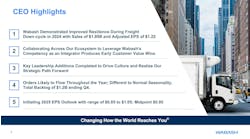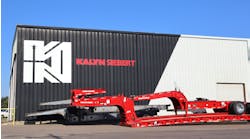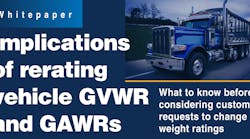By Bob Raybuck, Director of Technical Services, NTEA
Steve Spata, Technical Assistance Director, NTEA
Companies with vehicle certification responsibilities are familiar with chassis gross vehicle weight rating (GVWR) and gross axle weight ratings (GAWRs), and their importance in the labeling portion of the certification process. Dealers and end users are often accustomed to these ratings from an enforcement perspective (for driver qualifications, bridge weight limits, and state licensing/titling requirements) and may request intermediate-, final- and altered-stage manufacturers of new vehicles to change original ratings to lower or higher values to minimize driver requirements or maximize cargo capacity.
These ratings, assigned as part of the certification process, represent that the vehicle meets all applicable F/CMVSS. Manufacturers (including incomplete chassis, intermediate, final and altered stage) prior to the first retail sale — where a vehicle is licensed and titled by an owner in a given U.S. state, or sold and delivered to a purchaser at the first retail level in a Canadian province or territory — have the authority to determine final ratings for a new motor vehicle. However, it’s important to understand how ratings are established by the OEM and implications of changing these ratings before considering such customer requests.
From Title 49, Part 571.3, GVWR and GAWR are defined as follows.
“Gross vehicle weight rating or GVWR means the value specified by the manufacturer as the loaded weight of a single vehicle.”
“Gross axle weight rating or GAWR means the value specified by the vehicle manufacturer as the load-carrying capacity of a single axle system, as measured at the tire-ground interfaces.”
Ratings are limits
GVWR and GAWRs are maximum weights the completed vehicle and individual axles, respectively, can bear and meet regulatory compliance requirements, durability and OEM warranty objectives. Since numerous variables can determine the GVWR and GAWRs established by the OEM, ratings should be considered the weakest link in the chain. As such, only the OEM would know which components or limiting factors set these ratings, so consulting the chassis manufacturer is the only way to determine if any rating changes are possible and to what extent.
For example, the F/CMVSS for braking systems requires a number of tests to be performed at GVWR and GAWR, including for the parking brake system and stopping distances. Assuming they are successful, weight ratings for these tests become factors used in the chassis configuration and ratings assigned by the OEM. However, the OEM may equip the chassis with suspensions/wheels/axles/tires with GAWRs totaling higher than the GVWR. This is common for chassis up to the Class 5–6 GVWR range, but does not automatically mean a higher GVWR is possible. More robust axle capacities allow weight to be distributed in a range to accommodate a greater variety of build configurations and applications for the same chassis, when loaded to its GVWR, without exceeding axle capacities. In heavier applications, where chassis are spec’d with a GVWR equaling the sum of axle capacities, this spec’ing norm limits how the vehicle must be configured and loaded to its GVWR. Otherwise, GAWRs can be exceeded if weight is biased forward or rearward of where total weight must be centered to maintain axle limits.
Can you add axles to increase GVWR?
This brings up a common misconception that GVWR can, or must, always be the sum of the GAWR values (something that comes up frequently when additional axles are installed on a new chassis). However, this is not the case. Even though the chassis may have more axles than it did originally, it does not mean it’s otherwise able to meet all brake system performance requirements at a higher GVWR. Also, because other factors (such as durability) can limit GVWR, this weakest link value could be determined by another factor that’s not related to the brakes. Additionally, OEM incomplete vehicle documents (IVDs) often contain prohibitive language for changing GVWR, preventing the final-stage manufacturer from using OEM IVD guidance as a basis to certify the vehicle. Warranty coverage can also be affected by these changes. Therefore, the only path forward would be if the OEM can provide an engineering review or other supporting information to the contrary for a given chassis.
What about lowering GVWR?
Another misconception is that lowering GVWR is an easy process because the chassis is already capable of more weight, so this is actually a better rating scenario. While this may seem accurate from a chassis capability perspective, such changes require OEM consulting guidance. Lowering GVWR could place the vehicle in a range where more regulatory compliance requirements apply (for which the intermediate-, final- or altered-stage manufacturer would become completely responsible).
For example, end users and dealers may request changing an off-the-lot chassis with a GVWR above 10,000 pounds to a value of 10,000 pounds or less in an attempt to prevent motor carrier operational requirements that would otherwise apply to the vehicle. This can void IVD guidance and pass-through certification, since numerous F/CMVSS and other regulations are applicable to vehicles with 10,000-pound or less GVWRs, but do not apply to vehicles with 10,001-pound or higher GVWRs. These include dynamic crash testing, and the base vehicle in a GVWR-lowering scenario may not be capable of meeting additional requirements of the lower GVWR. Further, a lower GVWR could put the truck in a new emissions category for which the base vehicle is not equipped or capable of achieving (potentially resulting in more regulatory compliance issues for the manufacturers, selling dealers and end users).
Approaching GVWR/GAWR changes
Since these ratings are not just arbitrary values on a label, as they might seem, changing them for end-user applications is not as simple as putting a different number on a sticker. And, there are no guarantees a given chassis can have different ratings, or accommodate the values requested. GVWR and GAWR changes must be evaluated on a case-by-case basis to first determine if it’s possible for the specific chassis. Then, if so, you need to identify component and/or programming changes needed for the chassis to match that of the same model, had it been ordered from the factory with identical ratings.
For an indication of what’s possible, review an OEM’s product offerings to see if a specific new chassis being considered for rating(s) changes is released by the OEM in the new rating configuration requested. Data compared should include, to the extent possible, model, model year, powertrain, wheelbase, etc., as these can all be factors in the established ratings. If not, this indicates even the chassis OEM is not producing a model variation in those ratings (which could be for a number of good reasons only the OEM would know). So, creating unique ratings not assigned by the chassis OEM would likely end up placing more (rather than less) responsibility on the multi-stage manufacturer for the consequences, and is not advisable. While dealers or customers may not share the manufacturer’s compliance burdens, OEM warranty implications can help bring the prospect of GVWR and GAWR changes to a more relatable context.
Get an OEM chassis engineering review
Again, these considerations lead back to the initial step in the process of consulting the chassis OEM to determine possibilities for changing ratings of a specific, new chassis that has already been manufactured. To aid in this process, truck dealers can initiate OEM engineering reviews by VIN to determine if a new chassis can have different ratings, and what (if any) changes are required to effectively reconstruct the chassis to match the factory configuration, had it been ordered originally with the desired ratings.
The OEM engineering review outcome — which would typically consist of a brief report letter specifying the chassis by VIN — will determine if new ratings (higher or lower) are possible as well as any necessary chassis changes and additional guidance to overcome prohibitive statements in the IVD.
The OEM report, if sufficient for the multi-stage manufacturer, can help provide the basis for establishing ratings for the new vehicle being certified. The dealer will likely need to handle any component and/or programming changes needed for the new chassis ratings in order to preserve the OEM chassis warranty for the customer.
Another critical step is to perform a thorough weight analysis to ensure any new ratings will not be exceeded. Final- and altered-stage manufacturers can help customers by making sure new ratings being considered are still appropriate for their application, even if the OEM provides information to support changing original GVWR and/or GAWRs.
What about re-rating used vehicles?
Keep in mind, certification and ratings assignment apply only to new motor vehicles. Once a vehicle has been completed in the final stage and licensed and titled by an owner in a given U.S. state, or sold and delivered to a purchaser at the first retail level in a Canadian province or territory, the certification obligation ends, along with assignment of ratings.
In a 2002 interpretation, National Highway Traffic Safety Administration (NHTSA) provided the following response to the concept of re-rating used vehicles.
“NHTSA has long taken the position that the only parties who can assign or modify a vehicle’s GVWR are the original manufacturer, a final stage manufacturer, or an alterer. The term "final-stage manufacturer" is defined in the agency’s regulations at 49 CFR 568.3 as "a person who performs such manufacturing operations on an incomplete vehicle that it becomes a completed vehicle." Even though it attached the refrigerated body to the cab and chassis of your delivery truck, Uhl Truck Sales cannot be regarded as the vehicle’s final stage manufacturer. That is because the cab and chassis were used at the time these manufacturing operations were performed.”
If the used vehicle gets a new body or has other modifications, does it need to be recertified?
In the same interpretation, NHTSA defines entities that perform modifications on used vehicles as modifiers, and states the following regarding their attempts to change ratings.
“Consistent with this description, a person who makes modifications to a used vehicle (i.e., a vehicle that has already been purchased for purposes other than resale) does not qualify as an "alterer," as that term is used in NHTSA’s regulations. NHTSA has stated in past interpretation letters that when a used vehicle is modified in such a manner that the originally assigned GVWR is inappropriate for the vehicle as modified, the modifier can affix an informational label to the vehicle, identifying its appropriate loaded weight. See, e.g., letter to James Barber dated April 2, 1997. The agency has noted, however, that it would not recognize the loaded weight specified by the modifier as the vehicle’s GVWR. That is because the modifier would not be in a position to assign the vehicle a new GVWR since he would not qualify as an original or final stage manufacturer or as a vehicle alterer. Consistent with these interpretations, NHTSA would not regard the value specified by Uhl Truck Sales on the label it affixed to your vehicle as the vehicle’s GVWR. The agency would instead recognize the 29,000 pound GVWR assigned by the vehicle’s original manufacturer. Because the originally assigned GVWR remains with the vehicle throughout its service life, no means are available for "recertifying" the vehicle with a lower GVWR.”
Can end users put their own certification labels on used vehicles?
No — certification labels are the only legitimately-recognized vehicle label to include GVWR and GAWRs. These labels, along with the ratings, can only be assigned by the final- or altered-stage manufacturer. As noted previously, the certification process ultimately represents a new vehicle complies with all applicable motor vehicle safety standards. It’s not advisable for anyone, especially end users, to represent that a used vehicle is capable of meeting newer standards which may have changed or become applicable since it was certified. This is why there is no method established for recertifying a used vehicle and assigning different ratings. As such, motor carrier enforcement (knowing engineering limits are assigned by new vehicle manufacturers) can refute labels installed on used vehicles in an attempt to avoid driver or other operational requirements based on these ratings.
Bottom line
Chassis OEMs are the only ones who
- know what limits their original ratings; and
- are in a position to assist multi-stage manufacturers of new vehicles in considering whether or not one of their products is capable of meeting all applicable regulatory requirements at different ratings from what they originally assigned during chassis manufacture, as well as chassis warranty implications.
In all applications, a thorough weight analysis is necessary to ensure ratings will not be exceeded for a customer’s application, whether or not new ratings are considered. There is no mechanism for changing ratings on used vehicles no longer under the certification process where ratings are assigned — so those final ratings are effectively cast for the vehicle’s life, and motor carrier enforcement can ignore ratings on labels applied to used vehicles.
Learn more
NTEA offers access to publications and reference materials on current regulations, safety standards, and other technical issues at ntea.com. To learn more about the tools, resources and solutions available to members, visit ntea.com/memberbenefits. Contact NTEA’s technical services team at [email protected] or 800-441-6832.









